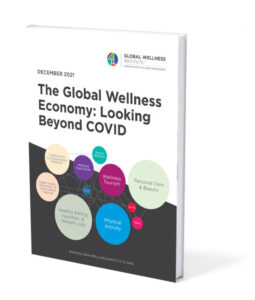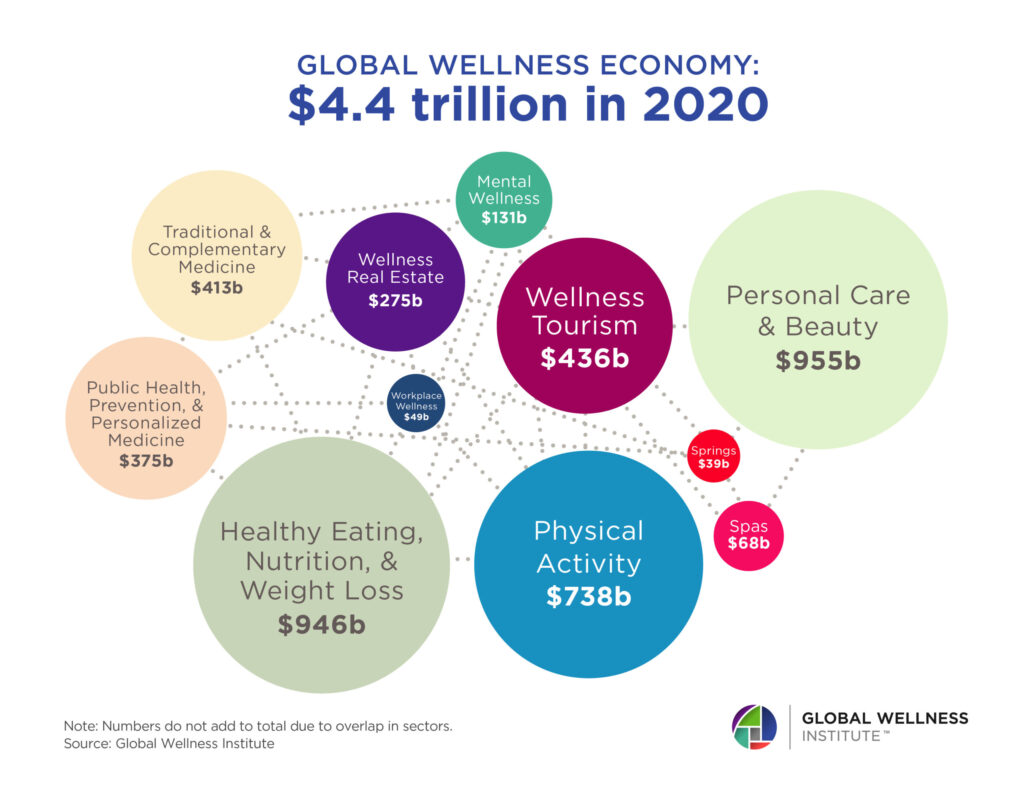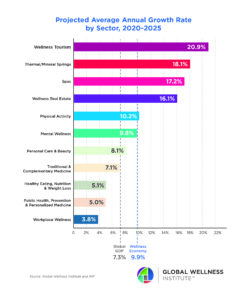By Liza Horan, Editor
The global wellness economy was on a spectacular roll, reaching a peak valuation of $4.9 trillion in 2019, just before Covid-19 hit. While imposed lockdowns devastated businesses that provided in-person services, other industry sectors boomed during the pandemic, according to research released today by the Global Wellness Institute. The overall focus on individual and community health and wellbeing brought on by the pandemic has poised the industry for even greater growth than previously forecasted.

The global wellness economy is projected to grow nearly 10% from a low point in 2020 to 2025, outpacing the rate of global GDP, according to the Global Wellness Institute’s latest research.
Today the Global Wellness Institute released an in-depth research report, “The Global Wellness Economy: Looking Beyond COVID,” stating that the industry is on track to grow from $4.4 trillion in 2020 to nearly $7 trillion in 2025. That’s an annual growth figure of 9.9%, which exceeds the forecasted global economy rate of 7.3%. The report, free to download, was released at the Global Wellness Summit in Boston during a press conference that also announced a strategic collaboration between GWI and BBC Global News to cover the wellness movement.
Here are key insights revealed in the 110-page report:
- 2019 was the biggest year on record for the global wellness economy, having reached a valuation of $4.9 trillion.
- The wellness sectors worst-hit by the pandemic were those that required touch or in-person facilities: Personal Care & Beauty (services and spending on supplies, down 13% in 2020), Physical Activity (facility closings and reduced spending on apparel and gear, down 15.5%, though the sub-sector of Fitness Technology jumped), and Wellness Tourism, Spas and Thermal/Mineral Springs (spending on each down nearly 40%).
- The pandemic brought increased spending on Fitness Technology (29.1%), a sub-sector of Physical Activity, as people purchase home equipment and relied on digital platforms; Wellness Real Estate (+22.1%), which is about the built environment and communities; Mental Wellness (+7.2%), which was accessible via individual activities at home or online; Public Health, Prevention & Personalized Medicine (+4.5%) as governments and organisations increased resources; Healthy Eating, Nutrition & Weight Loss (+3.6%), which was very much about increasing immunity and staying healthy, though in some places revenue from food sales increased because prices rose.
- The sectors that were hurt by the pandemic are forecasted to grow in the next few years. Workplace Wellness, a recent addition to the analysis, is anticipated to grow 3.8% by 2025. The biggest growth through 2025 is expected to be Wellness Tourism (+20.9%) as the travel industry bounces back and people recognise the value of restorative time.
“GWI predicts that the wellness economy will return to its robust growth and will continue to expand its share in consumer spending and the global economy,” report authors Katherine Johnston and Ophelia Yeung state. “In spite of the temporary shocks from the COVID-19 pandemic, the underlying forces that propel the growth of wellness remain as compelling as ever, including the growing global middle class, population aging, the ongoing rise of chronic disease, and expanding consumer interest in and awareness of healthy lifestyles. And, the pandemic has brought new shifts that accelerate many wellness drivers, including a growing awareness of the role of the built environment in health, a growing focus on mental health and wellbeing, a rethinking of the balance of work and life, an expanding focus on social justice and environmental sustainability, and much more.”
RELATED CONTENT
- Silver lining of pandemic is a universal shift to wellness
- GWI researcher Katherine Johnston discusses the mental wellness economy on The Mindstream Podcast
- View all Mindstream content covering the Global Wellness Institute.

The wellness economy peaked at $4.9 trillion in 2019 — then Covid-19 hit, dropping the figure to $4.4 in 2020. Still, it’s projected to expand to nearly $7 trillion in 2025. The wellness sector, unlike many other economic sectors, has a sophisticated data tracking and research analysis operation that was initiated by the Global Wellness Institute in 2014.
#2021GWS


Comments